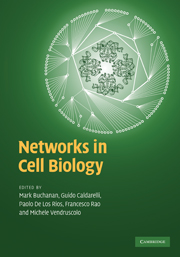Book contents
- Frontmatter
- Contents
- List of contributors
- Introduction
- 1 Network views of the cell
- 2 Transcriptional regulatory networks
- 3 Transcription factors and gene regulatory networks
- 4 Experimental methods for protein interaction identification
- 5 Modeling protein interaction networks
- 6 Dynamics and evolution of metabolic networks
- 7 Hierarchical modularity in biological networks: the case of metabolic networks
- 8 Signalling networks
- Appendix A Complex networks: from local to global properties
- Appendix B Modelling the local structure of networks
- Appendix C Higher-order topological properties
- Appendix D Elementary mathematical concepts
- References
- Index
3 - Transcription factors and gene regulatory networks
Published online by Cambridge University Press: 05 June 2012
- Frontmatter
- Contents
- List of contributors
- Introduction
- 1 Network views of the cell
- 2 Transcriptional regulatory networks
- 3 Transcription factors and gene regulatory networks
- 4 Experimental methods for protein interaction identification
- 5 Modeling protein interaction networks
- 6 Dynamics and evolution of metabolic networks
- 7 Hierarchical modularity in biological networks: the case of metabolic networks
- 8 Signalling networks
- Appendix A Complex networks: from local to global properties
- Appendix B Modelling the local structure of networks
- Appendix C Higher-order topological properties
- Appendix D Elementary mathematical concepts
- References
- Index
Summary
Introduction
Specific sensory and signaling systems allow living cells to gather and transmit information from the environment. All perceived signals are used in order to adjust cellular metabolism, growth, and development to environmental conditions. At the same time the cell is able to sense the intracellular milieu, e.g. energy and nutrient availability, redox state and so on and it accordingly adapts its physiological state. The importance of such changes in cellular processes is underlined by the presence of multiple regulatory systems (see Table 3.1), the most important of which controls the rate of transcription of a gene. The extremely different cell types in higher eukaryotes are a consequence of expression pattern differences, as well as cellular proliferation and differentiation, which are controlled by complex regulatory circuits originating space- and time-dependent transcriptional patterns. Thus, understanding the dynamic link between genotype and phenotype remains a central issue in biology.
Signals sensed by the cell are translated into changes in the rate of transcription of well-defined groups of genes through the activation of specific proteins (transcription factors, TF). TFs have high affinity for specific short sequences located upstream of genes and regulate transcription either positively or negatively. The binding of a TF to its target on the gene's promoter controls when expression occurs, at what level, under what conditions, and in which cells or tissues [662]. Interactions with other proteins, chromatin remodeling, modification complexes and the general transcription machinery affect the DNA-binding characteristics of a TF thereby influencing the rate of transcription.
- Type
- Chapter
- Information
- Networks in Cell Biology , pp. 36 - 52Publisher: Cambridge University PressPrint publication year: 2010



